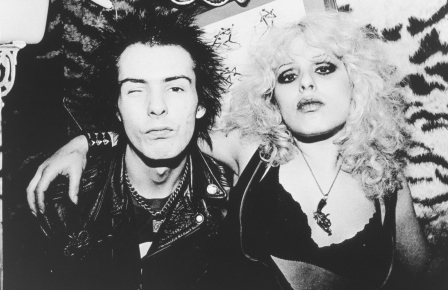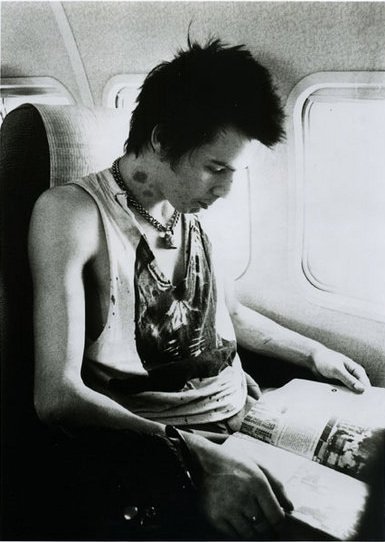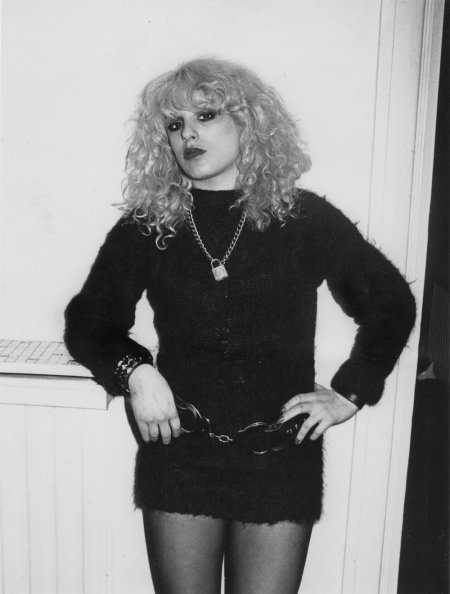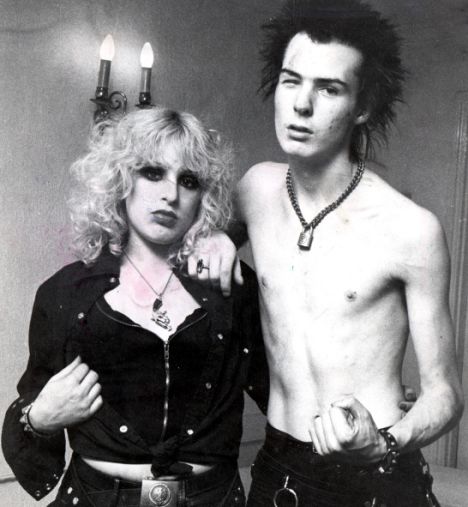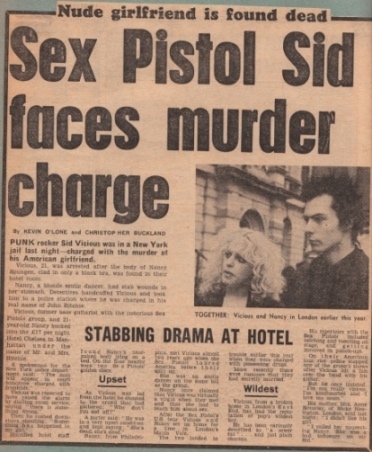|
Sid and Nancy
Many young people identify with the tragic lives of Sid and Nancy. Their story is part Romeo and Juliet, part Venus in Furs
Sid and Nancy, despite their youth and vulnerability, were legitimately scary. For all the commercialization of punk fashion and the alienated sneer, Nancy Spungen and Sid Vicious still look...well...vicious. These are not people you laugh at to their face, unless you want to be hit by a chain or a broken beer bottle. For young people living in an air-conditioned nightmare, this kind of brutality, even if it's self-destructive, is somewhat refreshing. Sid and Nancy have become more myth than fact. The influence of this myth extends from the "heroin chic" phenomenon to kinderwhore and Courtney Love. To most people, they're "a tabloid grotesque, wedged between the Son of Sam in '77 and John Lennon's murder in '80." But the couple's chemistry and defiance, set against the backdrop of late-1970s NYC, might seem attractive to some aggressively self-destructive young people. To others, Nancy Spungen is a Yoko Ono for the punk rock movement, or "Nauseating Nancy" as she was then called. Nobody really knows what happened the morning she died, but some people have gone so far as to say she got what she deserved. Well, almost everyone in the early punk movement had mental problems. Neither Sid nor Nancy are unique in that respect. But why did this young couple become iconic––and why did their tragic end also end the first wave of punk rock? I remember hearing an amazingly mediocre song on the radio (so mediocre I don't even remember what it sounded like) where the singer half-whispered, half-sang "Girl, me and you's like Sid and Nancy." Like it was the sexiest thing in the world. Put into plain English, he was saying something like "Girl, me and you's like two very young, disturbed, codependent drug addicts." Just what every girl wants to hear from her beau. Figuring out how this became sexy––or something playable on ClearChannel––is a project for a dissertation, not a webpage. But I can work around the edges. Sid Vicious (John Simon Ritchie)
Sid would shuffle in, wearing a long red teddy-boy jacket over skintight jeans and bare chest or the red T-shirt bearing a black swastika, his great height exaggerated by long, impossibly skinny legs and skeletal torso. The jet black, spiky brush of hair framed a face paler than porcelain, which highlighted delicate eyebrows over suspicious eyes and features shifting as constantly as light, twitching into a snarl at the suggestion of imagined danger. When secure or asleep, it was a vulnerable, beautiful face. Sid, on image alone, is what all punk rests on. Sid Vicious had a lot of pressure on him after the Sex Pistols broke up. Although he could never play bass, his charisma made him a "voice of the mo(ve)ment." The press saw him as the devil incarnate. Things didn't look very bright for Vicious; he had a serious drug problem, he spent most days watching cartoons and using drugs, and the offers were not exactly pouring in. Born in London, raised there and in Ibiza, Vicious (born John Simon Ritchie) was a mainstay of the early London punk scene. His name, "Sid Vicious," was originally a joke, because he was so mild-mannered and shy. Sid played in Siouxsie and the Banshees and the Flowers of Romance. He might have been the singer for the Damned, had he not missed the audition. After Johnny Rotten (a.k.a. John Lydon) and Glenn Matlock had a falling out, Johnny Rotten recommended Sid Vicious to play bass in the Sex Pistols. Vicious could not play bass very well; what he lacked in talent, he more than made up for with charisma. Vicious's pre-existing problems only worsened with fame. According to Lydon, Up to that time, Sid was absolutely childlike. Everything was fun and giggly. Suddenly he was a big pop star. Pop star status meant press, a good chance to be spotted in all the right places, adoration. That's what it all meant to Sid. I never dreamed he would perceive it that way. I thought he was far smarter.Smart or not, joining the Sex Pistols gave Vicious "carte blanche to go out of control." He got heavily into drugs and violence. The band's American tour was studded with disasters, despite the omnipresence of various bodyguards and "minders." Vicious ran into enablers and disturbed American fans, which did not help him psychologically. The tour ended on a whimper in San Francisco. When he reunited with his girlfriend in New York, Sid's prospects looked bleak. Sid's most famous article of clothing is his leather jacket. His look partly came from the influence of Vivienne Westwood, partly from the old rebel "uniform," which meant a motorcycle jacket, tight jeans (or bondage pants), and black boots. Sid sometimes wore a Nazi swastika on his t-shirt, ostensibly as some kind of political or anti-political statement. Second to his jacket in fame is a chain-link necklace with a padlock. Apparently there was no key for the padlock. (Nancy wears a similar necklace in these photos). Nancy Spungen
Nancy just wanted to be somebody (not necessarily herself). Nancy Spungen suffered from psychological problems her entire life. In the book And I Don't Want to Live This Life Nancy had a genius-level IQ, but her personal problems kept her from excelling in her studies, or in anything else. She was bored at university and spent much of her time there scoring drugs. At age seventeen, Spungen ran off to New York City, where she used drugs to meet musicians. She supported herself, at least in part, as a dancer and a prostitute. She soon earned the nickname "Nauseating Nancy" for being difficult and whiny; the other groupies shunned her. By 1977, she had worn out her welcome, and she moved to London to "get herself a Sex Pistol." Nancy was short and a bit overweight. She wore all black clothes, including rubber bondage gear, fishnet shirts, and large, studded leather belts. Her clothes tended to be too small for her, which made her look larger than she actually was. This look was not flattering, but it was distinctive. She also wore jewelry; in one photo, she's wearing a necklace with a toy handgun on it; in another, she wears a heart-shaped locket, and a silver ring. Later photos show Sid and Nancy with matching padlock necklaces. Nancy dyed her curly hair bright blonde; it was naturally "mousy brown." In later pictures, Nancy's face is caked in makeup, with candy red blush and lipstick, black eyeliner, and paper-white skin. At some point she said she would "kill [her]self when the first wrinkle appears." She didn't live long enough. Their Relationship
One afternoon...the three of us were sitting on their bed, stoned. It was a really hot afternoon and Nancy was in bra'n'pants. She starts saying she wants a drink, and as Sid is on the edge of the bed, can he get it for her? He ignores her and it all goes quiet. Suddenly he picks up an ashtray and hits her across the head with it. Sid and Nancy were together for almost two years, from early 1977 to October 1978, when Nancy died. The relationship was like fire and gasoline--passionate, intense, but short-lived and fast-burning. Sid and Nancy verbally, and physically, hurt one another, to the point of drawing blood or reaching "complete despair." Although there were tender moments, the overall dynamic of their relationship was dysfunctional, codependent and abusive. Some people claim Spungen introduced Vicious to heroin, but little evidence supports this. Sid is on record saying "I've been doing every-fuckin'-thing they reckon she turned me onto two years before I met her." It's possible, in fact likely, that their codependent relationship worsened their pre-existing problems. They weren't monogamous, but Nancy was intensely jealous of any girl who even looked at Sid––jealous to the point of violence. In Please Kill Me, Leee Childers described Vicious's confusion about his sexuality, and his fear that he might be gay or attracted to men. Nancy, a former dominatrix, stripper and sex worker, helped introduce Vicious to his own sexuality, and thus to his own charisma. At some point after the Sex Pistols broke up, Nancy became Sid's manager. She planned to find a methadone clinic in New York, get clean and promote Sid's career. This never got off the ground. Though they could get clean for a few weeks, eventually they always returned to heroin. The gigs Spungen arranged for Sid often failed, sometimes spectacularly. A famous clip, from to movie D.O.A. Sid and Nancy relied on each other. "I think he cared about her more than he cared about himself," said an anonymous friend. "Sexually they had a really normal, good relationship. That was the strong point––the rest of it was just games. They got so wound up in the punk image...because the media kept pushing them." Spungen was Sid's simultaneous "lifeline and his ruler," according to Lester Bangs. They were both children on a suicide mission; company, mutual understanding, even some warped and brittle intimacy was doubtless invaluable to them in their final months on earth. The End
A young woman is dead. I don't care. You probably don't care. The police don't care. The papers don't care. The punks for the most part don't care. The only people that care are (I suppose) her parents and (I'm almost certain) the boy accused of murdering her. In the fall of 1978, Sid and Nancy were living in the Chelsea Hotel in New York City, then a hotel full of junkies and "scavengers." In order to make money to score, Sid and Nancy would sometimes give "exclusive interviews" to tabloids, fueling their myth while they were still alive. "The press portrayed Sid and Nancy as Romeo and Juliet in black leather, roaring into hell," according to Spungen's mother. And they were more than happy (well, happy is the wrong word) to live up to this image. For all of his swagger, Vicious's options were shrinking. He had no record contract. Nobody was lining up to play with him. He and Nancy were "going down the toilet as a couple," so much so that even the hardcore drug addicts didn't hang out with them. The image of punk was already on the decline. Many people viewed Sid as a torch-carrier for punk rock; he had dropped it by any stretch of the imagination. Punk had gone from being a youth movement to a tabloid joke. Interviewer: Where would you like to be? If punk was a joke, it wasn't a very funny one. Today one can see watered-down versions of their look in the mall. The "punk" leather jacket has become an essential accessory for any mild nonconformist. "Sid and Nancy" are remembered less for who they are than who we want them to be: a "punk rock Romeo and Juliet" with all the romance and none of the tragedy. Nancy Spungen died in the early morning of October 12, 1978, from a stab wound to her abdomen. No one knows for sure whether she killed herself, was murdered by Sid or someone else. With her, and with Sid's suicide/overdose a few months later, much of the promise of punk died as well. The last days of this couple were later made into a film, Sid & Nancy Sid and Nancy are still relevant today. Drug addiction and abusive relationships have not yet vanished. Performers like the late Amy Winehouse had to live their addictions out in the new media glare––where any cell-phone video can instantly ruin a reputation. 1970s New York is gone, never to return. It's up to us to find, or create, something new. Related Reading: Riot Grrrl Style, Fashion and Self-Expression  References: D.O.A.: A Right of Passage
The Filth and the Fury - A Sex Pistols Film Lydon, John. Rotten: No Irish, No Blacks, No Dogs McNeil, Legs and McCain, Gillian. Please Kill Me: The Uncensored Oral History of Punk Robinson, Charlotte. So Tough: the Boy Behind the Sid Vicious Myth. PopMatters Music Features, 9 August 2006. Schoemer, Karen. Is It Too Easy to Hate Nancy Spungen? New York Magazine, 19 October 2008. Savage, Jon. The England's Dreaming Tapes Spungen, Deborah. And I Don't Want to Live This Life Steward, Sue. "Sid and Nancy: the Habitat years" Accessed 12 June 2010 at http://www.telegraph.co.uk/culture/music/3553652/Sid-and-Nancy-the-Habitat-years.html Sid Vicious. Article on wikipedia.org. Most of these photographs from an excellent website on Nancy Spungen. Our article on Sid and Nancy is part of our Subcultures and Icons sections. Return to Enjoy Your Style's home page. Search Enjoy Your Style: |
Search this site:





